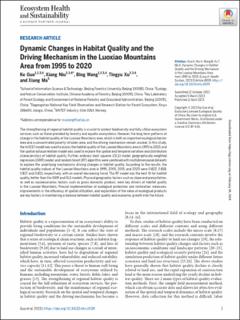Dynamic changes in habitat quality and the driving mechanism in the Luoxiao Mountains area from 1995 to 2020
Peer reviewed, Journal article
Published version

View/
Date
2023Metadata
Show full item recordCollections
- Publikasjoner fra CRIStin - SINTEF AS [5801]
- SINTEF Industri [1566]
Abstract
The strengthening of regional habitat quality is crucial to protect biodiversity and fully utilize ecosystem services such as those provided by forestry and aquatic ecosystems. However, the long-term patterns of change in the habitat quality of the Luoxiao Mountains area, which is both an important ecological barrier area and a concentrated poverty-stricken area, and the driving mechanism remain unclear. In this study, the InVEST model was used to assess the habitat quality of the Luoxiao Mountains area in 1995 to 2020, and the spatial autocorrelation model was used to explore the spatial and temporal variation and distribution characteristics of habitat quality. Further, ordinary least squares (OLS) model, geographically weighted regression (GWR) model, and random forest (RF) algorithm were combined with multidimensional datasets to explore the underlying mechanisms driving changes in habitat quality. According to the results, the habitat quality indices of the Luoxiao Mountains area in 1995, 2005, 2015, and 2020 were 0.822, 0.818, 0.817, and 0.813, respectively, with an overall decreasing trend. The RF model was the best fit for habitat quality, better than the GWR and OLS models. Physical geographic factors such as slope and precipitation, as well as socioeconomic factors such as gross domestic product, were key drivers of habitat quality in the Luoxiao Mountains. Precise implementation of ecological protection and restoration measures, improvements in the efficiency of spatial utilization, and exploration of the value of ecological products are key factors in maintaining a balance between habitat quality and economic growth into the future.
